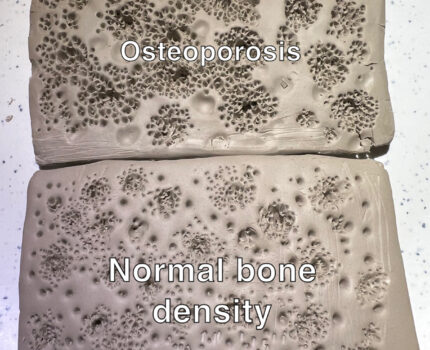Tristan Dellingner
Don Larson
BIOL_F111X
Nov 21, 2023
The Effect of Osteoporosis
Osteoporosis is a condition in which the density of bone is decreased. Bone naturally has many small holes in it so that nutrients and other resources can pass through. With osteoporosis however these holes or cavities become larger. The decreased density of the bone makes it not so structurally strong as it once was. This condition leaves bones vulnerable to fractures with little pressure or trauma. Something as simple as twisting your ankle for someone without osteoporosis would be a complex fracture for someone with hsi condition.
There are two types of osteoporosis the first is postmenopausal osteoporosis which is type one and type two is age related osteoporosis. Type two is found in men and women and naturally occurs from aging and decreased need for strong bones. The less work that is put on your bones they will shed some of their strength. The second type of osteoporosis is different because it only affects women and is the result of low estrogen levels following menopause.2
Osteoporosis is diagnosed using the help of imaging, blood work, previous fracture history, and physical examinations. One type of imaging that a provider can use to get an idea of whether a patient may have osteoporosis is called a dual-energy x-ray absorptiometry (DXA) sometimes just called a bone density scan. This scan will provide you with the level of bone density the patient currently has. Osteoporosis is diagnosed if the patient receives a result value that deviates 1-2.5 from the standard mean.
There are also different stages of osteoporosis. The first stage actually has a different name: it is called osteopenia. Osteopenia is when a person has low bone mass but not necessarily osteoporosis yet. After that the next stage is osteoporosis which is classified based on the result values i discussed in the previous paragraph. To diagnose severe osteoporosis however there needs to be a history of several fragility fractures. Many people who have osteoporosis have had a few fractures though so it is not rare to see severe osteoporosis.
Osteoporosis mainly affects women and is not commonly seen amongst men. According to Glasser “By age 75, an estimated 38% of white women will have osteoporosis and 94% will have low bone mass”. As we can see from this quote it is not rare to have osteoporosis, it is actually very common. Osteoporosis doesn’t just affect older people or post menopausal women. This condition commonly also affects postpartum women.
Bone is a tissue that is constantly being broken down and created. This process is done through bone resorption and bone formation. With osteoporosis bone is being broken down quicker than it can be formed which causes loss of needed bone density. During menopause the sex hormone estradiol or estrogen which is normally abundant dramatically decreases causing an imbalance in the hormone of the body. With this, levels of FSH ( follicle stimulating hormone) rise. PTH (Parathyroid hormone) levels also increase during menopause which causes the bone stores to push out all the calcium and it also increases bone resorption. There are many factors which contribute to the decreasing levels of bone density but most if not all of these factors can be linked back to the low estrogen levels.
My project using clay slats is a model of what normal bone density looks like and what osteoporosis looks like. If you were to say cut a bone down the middle in half these clay slates are what the cut sides of the bone would look like. The model for osteoporosis has deeper cavities and they are less spread out. The more and deeper cavities are what causes these bones to be so frail.
Works Cited
From the Departments of *Orthopaedic Surgery and †Medicine. “Osteoporosis: Definition and Clinical Presentation : Spine.” LWW, journals.lww.com/spinejournal/Fulltext/1997/12151/Osteoporosis__Definition__and_Clinical.3.aspx. Accessed 21 Nov. 2023.
Ji, Meng-Xia, and Qi Yu. “Primary Osteoporosis in Postmenopausal Women.” Chronic Diseases and Translational Medicine, U.S. National Library of Medicine, 21 Mar. 2015, www.ncbi.nlm.nih.gov/pmc/articles/PMC5643776/.
Sözen, Tümay, et al. “An Overview and Management of Osteoporosis.” European Journal of Rheumatology, U.S. National Library of Medicine, Mar. 2017, www.ncbi.nlm.nih.gov/pmc/articles/PMC5335887/.


The objectives that are covered in the following project are to “know the stages of bond development and repair.” I really enjoyed reading the excerpt that the participant included while showing off their clay project on bone density and osteoporosis. The participant chose to explain what the causes and effects are when it comes to osteoporosis, and this caused me to learn a lot about the topic. Osteoporosis is a condition where the bone density starts to decrease, which makes the bone less strong than it originally was. This condition is more common when it comes to women than it is with men. There are two different types of osteoporosis, each one is due to a different cause. For example, there is postmenopausal osteoporosis which is also known as type one osteoporosis. Type one is commonly referred to as age-related osteoporosis. Each type of condition is self-explanatory when it comes to the causes. The only way to find out if an individual has osteoporosis (in order to diagnose them) is with the help of imaging, blood work, physical examinations, and lastly looking into previous fracture history. Thank you again for sharing this project, I really enjoyed reading what you had to share.